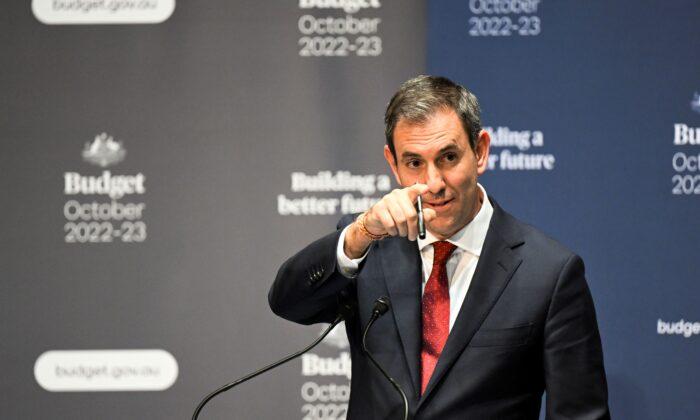What the Australian Treasurer Jim Chalmers tabled on Oct. 25 was not a budget in the traditional sense but a mini-budget or update. Unlike a regular annual budget there were few announcements of new policies or fiscal strategies.
But it suited Chalmers to elevate it to the status of a budget for dramatic effect—to emphasise his point that the budget numbers will worsen in the medium to longer term.
Politically, a new treasurer can afford to do this because he can lay the blame on the previous government. But Chalmers offered no new fiscal strategy to deal with fundamental problems.
The budget essentially re-calibrates the fiscal outlook by doing two things.
First, it shoehorns the new government’s election promises into the previous government’s 2022–23 budget and finds some savings to partially offset the costs.
Second, it rebases the budget on updated or different economic assumptions (such as lower productivity growth and higher interest rates) and updated assessments of the cost of spending programs (such as the National Disability Insurance Scheme).

In doing this, the update highlights an enduring deficit problem. After shrinking dramatically in the last (2021–22) fiscal year, the projected deficit worsens again and stabilises at around two percent of GDP. This is worse—but not dramatically so—than previously known, but Chalmers offers no solutions, leaving it to for future budgets.
He hints at some combination of tax increases and tighter control over expenditure.
The “national conversation” that Chalmers wants to have over the months ahead is about what the balance should be between higher taxes and lower spending to balance the budget over time.
Thus, the new government has eschewed a “Big Bang” approach to the fiscal problem and opted for a gradual reset of the public’s expectations in the direction of future spending cuts and tax hikes.
Rampant Spending
According to the budget numbers, spending will be about 27 percent of GDP in the next few years and then edge up to 28 percent in the early 2030s. This share has rarely been higher than 27 percent and never 28 percent.Since 2000, excluding the global financial crisis and pandemic periods, both of which saw sharp spikes in spending in exceptional circumstances, spending has averaged at 24.5 percent of GDP.
Revenue, according to this budget, will settle at about 25 percent of GDP and then edge up to 26 percent in the early 2030s. The current level of revenue has rarely been exceeded in history and at 26 percent of GDP would equal past records.
These comparisons point to the problem being too much spending rather than too little revenue.
While economists often make the case for tax reform in Australia, there is also a pressing need for reform of government expenditure to make spending programs more efficient and effective.
There’s also the need to curb the future growth of spending that raises the real prospect of the public sector becoming larger than it has ever been in peacetime.
While all areas of government spending should be reviewed, particular attention should be paid to the large and fast growing programs in disability care (the NDIS), health, aged care, child care, school education, and defence. These accounted for 29 percent of federal spending in 2013–14 but also for 54 percent of the increase over the subsequent 10 years.





